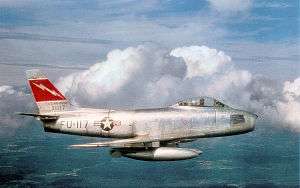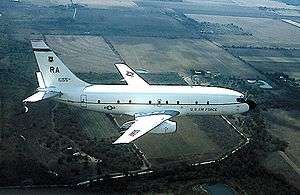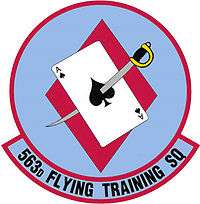563d Flying Training Squadron
| 563d Flying Training Squadron [1] | |
|---|---|
|
563d Flying Training Squadron Patch | |
| Active |
24 December 1942 - 28 August 1945 12 June 1947 - 27 June 1949 23 November 1953 - 10 December 1957 1 May 1962 - 31 July 1972 31 July 1975 - 5 October 1989 14 May 1993 - 3 June 1996 30 April 1999 - 15 November 2010 |
| Country | United States |
| Branch | United States Air Force |
| Type | Navigator Training |
| Part of |
Air Education and Training Command Nineteenth Air Force 12th Flying Training Wing 12th Operations Group |
| Garrison/HQ | Randolph Air Force Base |
| Engagements |
Schweinfurt–Regensburg mission Operation Rolling Thunder |
| Decorations |
|





The 563d Flying Training Squadron (563 FTS) was part of the 12th Flying Training Wing based at Randolph Air Force Base, Texas. It operated the T-43 Bobcat conducting navigator training. It was most recently inactivated at a ceremony held at Randolph Air Force Base on November 15, 2010.
History
The 563d was first activated as a bombardment squadron in 1942 at Gowen Field, near Boise, Idaho. It transferred to Wendover Field, Utah in early 1943 to train in B-17 Flying Fortress aircraft. In the spring of 1943, the unit deployed to RAF Knettishall, England. As part of the Eighth Air Force, the unit flew several combat missions from 17 July 1943 to 21 April 1945 over Germany, France, Poland, Belgium, Norway, Romania and the Netherlands. While in combat, the unit received two Distinguished Unit Citations: one for the Regensburg raidon 17 August 1943, and another for separate attacks on Hanover, the Ruhr, and a "shuttle-bombing" raid. After V-E Day, the unit transferred back to the U.S. awaiting movement to the Pacific Theater of Operations, but the Japanese surrender altered these plans and the unit was inactivated in August 1945.[2]
The squadron was reactivated in the Reserves from 12 June 1947 to 27 June 1949, flying the AT-6 Texan, AT-11 Kansan, C-46 Commando, C-47 Skytrain, and A-26 Invader at Orchard Place Airport, Chicago, Illinois.[2]
The 563d was reactivated again in 1953 following Secretary of State John Foster Dulles' promise to provide NATO with four fighter wings. The unit became a fighter-bomber squadron at Clovis Air Force Base, New Mexico, 23 November 1953, where its members trained in F-86 Sabre aircraft. The squadron moved to Bitburg Air Base, Germany, in 1954, and then to Étain-Rouvres Air Base, France, in the summer of 1955. The unit flew support for the Suez Canal and Hungarian crises. It converted to F-100 Super Sabre aircraft on 2 April 1957 and was inactivated shortly after on 10 December 1957.[2]
The squadron was reactivated 1 May 1962, with the 23d Wing (the famous Flying Tigers) as the 563d Tactical Fighter Squadron, at McConnell Air Force Base, Kansas, again flying the F-100 Super Sabre and then the F-105 Thunderchief by the end of 1963. In April 1965, the unit was sent into combat in Southeast Asia. The 563d deployed to Takhli Royal Thai Air Force Base, Thailand, and flew 1508 combat sorties over North Vietnam and Laos. On 27 July 1965, the unit participated in the first destruction of a surface-to-air missile site in North Vietnam. In addition, there were several attacks as part of the first increment of Operation Rolling Thunder, and other Operation Iron Hand missions, and several dangerous attempts to destroy the Thanh Hoa and Paul Doumer bridges. The 563d lost 10 of its original 18 F-105Ds. Two pilots were killed by enemy action and three became POWs in that five-month tour. The 563d was awarded two Air Force Outstanding Unit Awards with Combat "V" for Valor for this tour, and was the most experienced Squadron in the U.S. Air Force. (The 563rd never received its Vietnam Cross of Gallantry with Palm citation though because its mission was classified.) In 1966, the squadron became a Replacement Training Unit back at McConnell. The unit trained ten classes of pilots for the F-105D between 1966 and 1970 and later transitioned to the F-105 "Thunderstick II" until its inactivation, 31 July 1972.[2]
On 31 July 1975, the 563d TFS was reactivated for the fifth time at George Air Force Base, California. The unit initially flew "Thunderstick II"'s but added F-4 Phantom II in September 1975. In October 1978, the 563d received new aircraft from Nellis Air Force Base, Nevada, to become the first operational squadron to fly the advanced F-4G Wild Weasel. The unit served with this electronic warfare aircraft in many exercises until it was inactivated in October 1989.[2]
On 14 May 1993, the 563d was redesigned as a flying training squadron and reactivated at Randolph Air Force Base, Texas. The squadron was assigned to the 12th Flying Training Wing under the Air Education and Training Command. In conjunction with the 562d Flying Training Squadron, it currently operates the T-43 Bobcat aircraft conducting Electronic Warfare Officer (EWO), or, Combat Systems Officer (CSO) training in electronic attack, threat reaction, and electronic surveillance. The 563d also operates the state of the art T-25 Simulator, aiding the Air Force in creating some of the most technically skilled Airmen the United States has to offer.[2]
Lineage
- Constituted 563d Bombardment Squadron (Heavy) on 19 Dec 1942
- Activated on 24 Dec 1942
- Redesignated 563d Bombardment Squadron, Heavy, on 20 Aug 1943
- Inactivated on 28 Aug 1945
- Redesignated 563d Bombardment Squadron, Very Heavy, on 5 May 1947
- Activated in the Reserve on 12 Jun 1947
- Inactivated on 27 Jun 1949
- Redesignated 563d Fighter-Bomber Squadron on 5 Nov 1953
- Activated on 23 Nov 1953
- Inactivated on 10 Dec 1957
- Redesignated 563d Tactical Fighter Squadron, and activated, on 1 May 1962
- Organized on 1 Oct 1962
- Inactivated on 31 Jul 1972
- Redesignated 563d Tactical Fighter Training Squadron on 15 Jul 1975
- Activated on 31 Jul 1975
- Re-designated 563d Tactical Fighter Squadron on 1 Jul 1977
- Inactivated on 5 Oct 1989
- Redesignated 563d Flying Training Squadron on 14 Dec 1992
- Activated on 14 May 1993
- Inactivated on 3 Jun 1996
- Activated on 30 Apr 1999
- Inactivated on 15 Nov 2010
Assignments
- 388th Bombardment Group, 24 Dec 1942-28 Aug 1945
- 338th Bombardment Group, 12 Jun 1947-27 Jun 1949
- 388th Fighter-Bomber Group, 23 Nov 1953-10 Dec 1957
- Attached to 388th Fighter-Bomber Wing, 1 Jul-10 Dec 1957
- Tactical Air Command, 1 May 1962
- 388th Tactical Fighter Wing, 1 Oct 1962
- 23d Tactical Fighter Wing, 8 Feb 1964
- Attached to 2d Air Division, 8-9 Apr 1965
- Attached to 6235th Tactical Fighter Wing [Provisional], 10 Apr-15 Aug 1965
- 832d Air Division, 1-31 Jul 1972
- 35th Tactical Fighter Wing, 31 Jul 1975
- 37th Tactical Fighter Wing, 30 Mar 1981-5 Oct 1989
- 12th Operations Group, 14 May 1993-3 Jun 1996; 30 Apr 1999-15 Nov 2010
Stations
|
|
Aircraft
|
|
See also
References
![]() This article incorporates public domain material from the Air Force Historical Research Agency website http://www.afhra.af.mil/.
This article incorporates public domain material from the Air Force Historical Research Agency website http://www.afhra.af.mil/.
- Maurer, Maurer, ed. (1983) [1961]. Air Force Combat Units of World War II (PDF) (reprint ed.). Washington, DC: Office of Air Force History. ISBN 0-912799-02-1. LCCN 61060979.
- Maurer, Maurer, ed. (1982) [1969]. Combat Squadrons of the Air Force, World War II (PDF) (reprint ed.). Washington, DC: Office of Air Force History. ISBN 0-405-12194-6. LCCN 70605402. OCLC 72556.
- 563d Flying Training Squadron History
- 563d Flying Training Squadron Fact Sheet


